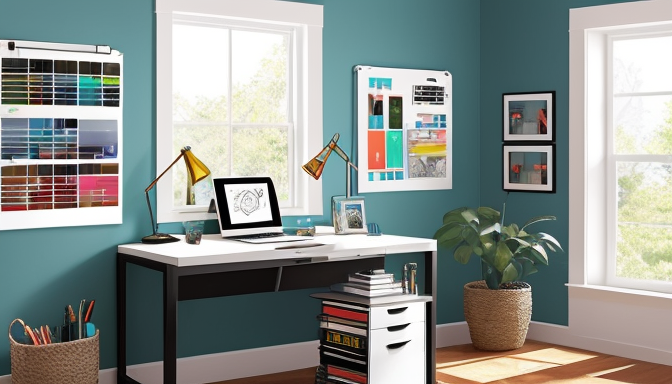Are you ready to embark on a journey from a novice to a pro in the world of design? Buckle up, because understanding the fundamentals of design is your first step towards creating stunning visuals that not only catch the eye but also communicate effectively. Design is not just about making things look pretty; it’s about creating meaningful experiences that resonate with your audience. Think of design as a conversation between you and your viewers, where every element plays a role in conveying your message.
To kick things off, let’s dive into the essential design principles. These principles are like the rules of the road for designers. They include balance, contrast, alignment, and hierarchy. Each of these elements contributes to the overall harmony of your design. For instance, balance ensures that your composition feels stable, while contrast draws attention to key areas. Imagine walking into a room where everything is perfectly arranged; it feels inviting, right? That’s the power of good design principles.
As you progress, mastering tools and techniques will elevate your skills even further. Familiarize yourself with industry-standard software and explore the intricacies of color theory and typography. These are not just technical skills; they are the brushes and paints in your creative toolkit. With each new technique you learn, you’ll find yourself equipped to tackle more complex projects with confidence. So, are you ready to transform your passion into a profession? Let’s get started!
Understanding Design Principles
When diving into the world of design, it’s crucial to grasp the fundamental principles that serve as the backbone of any effective composition. Think of these principles as the rules of a game; understanding them allows you to play creatively and confidently. At the core of design are concepts like balance, contrast, and alignment, each playing a pivotal role in creating visually stunning and harmonious layouts.
Balance is about distributing elements evenly across your design. Imagine a seesaw; if one side is heavier, it tips over. In design, achieving balance ensures that no single element overwhelms the others, creating a sense of stability. Similarly, contrast is your best friend when it comes to making elements stand out. By juxtaposing light and dark, large and small, you draw the viewer’s eye to what matters most. It’s like seasoning in cooking—too little and it’s bland, too much and it’s overwhelming.
Then there’s alignment, which ensures that every element feels connected. Think of it as the invisible thread that stitches your design together. When elements are well-aligned, they create a clean, organized look that guides the viewer’s eye naturally through the composition.
In essence, mastering these design principles is not just about following a set of rules; it’s about understanding how to manipulate them to create a visual story that resonates with your audience. So, are you ready to elevate your design game?

Tools and Techniques for Designers
When it comes to design, having the right tools and techniques can make all the difference between a novice and a pro. Think of your design toolbox as a chef’s kitchen; without the proper utensils, even the best ingredients can’t create a culinary masterpiece. So, let’s dive into the essentials you need to elevate your design game!
First off, mastering design software is crucial. Programs like Adobe Photoshop and Illustrator are industry standards, but don’t overlook user-friendly options like Canva for quick projects. Each tool has its unique strengths, so experimenting with them can unlock your creative potential. For instance, Photoshop is fantastic for photo editing, while Illustrator shines in creating vector graphics.
Next, let’s talk about color theory. Understanding how colors interact can transform your designs from mediocre to stunning. Utilize the color wheel to find complementary colors that pop. A well-thought-out color palette can evoke emotions and set the tone for your project. To help you grasp this concept, here’s a simple table summarizing color relationships:
| Color Relationship | Description |
|---|---|
| Complementary | Colors opposite each other on the color wheel |
| Analogous | Colors next to each other on the color wheel |
| Triadic | Three colors evenly spaced around the wheel |
Lastly, let’s not forget about typography. The right font can convey your message more powerfully than images. Experiment with different typefaces and pay attention to font pairing to create a hierarchy in your designs. Remember, less is often more; don’t clutter your work with too many fonts.
In conclusion, mastering these tools and techniques is not just about knowing how to use them; it’s about understanding when and why to use them. With practice and experimentation, you’ll find your unique style and voice as a designer. So, roll up your sleeves and get started—you have the power to create stunning visuals!
Frequently Asked Questions
- What are the core design principles I should know?
Understanding the core design principles like balance, contrast, and alignment is crucial. These principles help create visually appealing and effective designs. Think of them as the rules of a game; knowing them can elevate your design skills from novice to pro!
- Which tools are essential for beginners in design?
As a beginner, you should familiarize yourself with tools like Adobe Creative Suite, Canva, and Figma. These platforms not only help you create stunning visuals but also streamline your workflow, making the design process smoother and more enjoyable.
- How important is color theory in design?
Color theory is super important! It’s like the secret sauce that can make or break your design. Knowing how colors interact can help you evoke emotions and create a strong visual impact. So, don’t skip this step!
- Can I learn design without formal education?
Absolutely! Many successful designers are self-taught. With the wealth of resources available online, including tutorials and forums, you can learn at your own pace and develop your unique style.